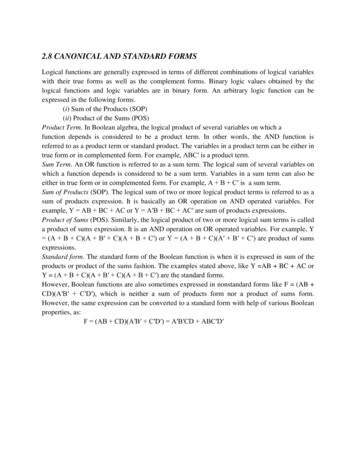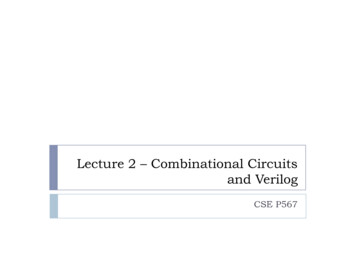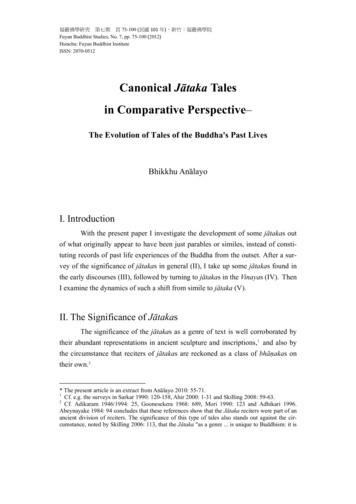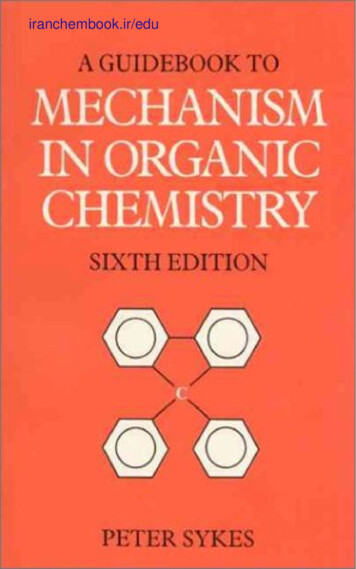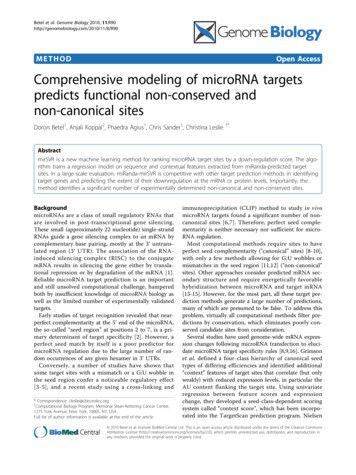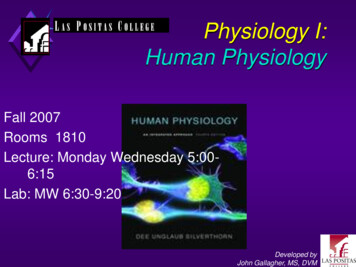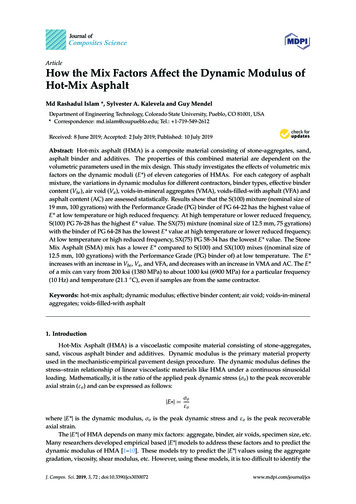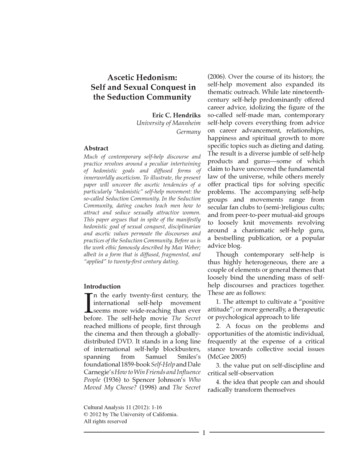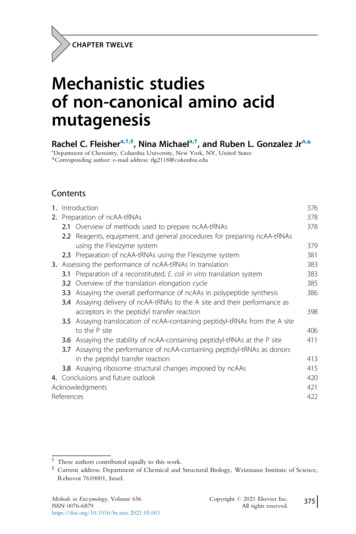
Transcription
CHAPTER TWELVEMechanistic studiesof non-canonical amino acidmutagenesisRachel C. Fleishera,†,‡, Nina Michaela,†, and Ruben L. Gonzalez Jra,*aDepartment of Chemistry, Columbia University, New York, NY, United States*Corresponding author: e-mail address: rlg2118@columbia.eduContents1. Introduction2. Preparation of ncAA-tRNAs2.1 Overview of methods used to prepare ncAA-tRNAs2.2 Reagents, equipment, and general procedures for preparing ncAA-tRNAsusing the Flexizyme system2.3 Preparation of ncAA-tRNAs using the Flexizyme system3. Assessing the performance of ncAA-tRNAs in translation3.1 Preparation of a reconstituted, E. coli in vitro translation system3.2 Overview of the translation elongation cycle3.3 Assaying the overall performance of ncAAs in polypeptide synthesis3.4 Assaying delivery of ncAA-tRNAs to the A site and their performance asacceptors in the peptidyl transfer reaction3.5 Assaying translocation of ncAA-containing peptidyl-tRNAs from the A siteto the P site3.6 Assaying the stability of ncAA-containing peptidyl-tRNAs at the P site3.7 Assaying the performance of ncAA-containing peptidyl-tRNAs as donorsin the peptidyl transfer reaction3.8 Assaying ribosome structural changes imposed by ncAAs4. Conclusions and future 381383383385386398406411413415420421422These authors contributed equally to this work.Current address: Department of Chemical and Structural Biology, Weizmann Institute of Science,Rehovot 7610001, Israel.Methods in Enzymology, Volume 656ISSN 1Copyright#2021 Elsevier Inc.All rights reserved.375
376Rachel C. Fleisher et al.AbstractOver the past decade, harnessing the cellular protein synthesis machinery to incorporate non-canonical amino acids (ncAAs) into tailor-made peptides has significantlyadvanced many aspects of molecular science. More recently, groundbreaking progressin our ability to engineer this machinery for improved ncAA incorporation has led tosignificant enhancements of this powerful tool for biology and chemistry. By revealingthe molecular basis for the poor or improved incorporation of ncAAs, mechanistic studies of ncAA incorporation by the protein synthesis machinery have tremendous potential for informing and directing such engineering efforts. In this chapter, we describe aset of complementary biochemical and single-molecule fluorescence assays that wehave adapted for mechanistic studies of ncAA incorporation. Collectively, these assaysprovide data that can guide engineering of the protein synthesis machinery to expandthe range of ncAAs that can be incorporated into peptides and increase the efficiencywith which they can be incorporated, thereby enabling the full potential of ncAA mutagenesis technology to be realized.1. IntroductionThe field of non-canonical amino acid (ncAA) mutagenesis aims toharness the power of the cellular machinery that translates messengerRNAs (mRNAs) into proteins, which we refer to here as the “translationmachinery” (TM), to make templated designer peptides with amino acidsother than the 20 canonical amino acids (cAAs) (Liu & Schultz, 2010).The applications of this technology are diverse, including the creation ofdifficult-to-synthesize therapeutics (Obexer, Walport, & Suga, 2017); novelmaterials (Katoh, Sengoku, Hirata, Ogata, & Suga, 2020; Rogers et al.,2018); and proteins engineered to contain biophysical probes (Braun,Drescher, & Summerer, 2019; Chung, Amikura, & Soll, 2020; Desai &Gonzalez, 2020; Lee, Kang, & Park, 2019; Saleh, Wilding, Calve,Bundy, & Kinzer-Ursem, 2019) or perform new functions (Drienovská &Roelfes, 2020; Wang, 2017). Despite this, many classes of ncAAs are poorsubstrates for the TM (Pavlov et al., 2009; Tan, Forster, Blacklow, &Cornish, 2004) and improving their incorporation into peptides oftenrequires engineering of the TM (Amiram et al., 2015; Dedkova & Hecht,2019; Fan, Xiong, Reynolds, & S oll, 2015; Hammerling, Kr uger, &Jewett, 2020; Katoh, Iwane, & Suga, 2017; Katoh, Tajima, & Suga,2017; Lajoie et al., 2013; Ohtsuki, Yamamoto, Doi, & Sisido, 2010; Parket al., 2011; Rackham & Chin, 2005; Rogers et al., 2018; Tharp et al.,2020; Tsiamantas, Rogers, & Suga, 2020). Recent breakthroughs in thesynthesis of ncAA-transfer RNAs (tRNAs) (Bianco, Townsley, Greiss,
Studies of non-canonical amino acid mutagenesis377Lang, & Chin, 2012; Desai & Gonzalez, 2020; Dunkelmann, Willis,Beattie, & Chin, 2020; Ernst et al., 2016; Liu, Hemphill, Samanta,Tsang, & Deiters, 2017; Liu & Schultz, 2010; Murakami, Ohta,Ashigai, & Suga, 2006; Neumann, Wang, Davis, Garcia-Alai, & Chin,2010; Wang, Brock, Herberich, & Schultz, 2001) and the engineering oftRNAs (Katoh, Iwane, et al., 2017; Katoh & Suga, 2018; Katoh, Tajima,et al., 2017), translation factors (Katoh, Iwane, et al., 2017; Katoh &Suga, 2018; Katoh, Tajima, et al., 2017; Park et al., 2011), and the ribosomeitself (Aleksashin et al., 2020; Chen et al., 2017; Dedkova et al., 2012;Dedkova, Fahmi, Golovine, & Hecht, 2003, 2006; Fried, Schmied,Uttamapinant, & Chin, 2015; Liu et al., 2014; Maini, Dedkova, et al.,2015; Neumann et al., 2010; Orelle et al., 2015; Schmied et al., 2018),particularly in the context of cell strains optimized for ncAA incorporation(Isaacs et al., 2011; Lajoie et al., 2013), have pushed the field to new heights.These developments have facilitated the incorporation of several classes ofncAAs that had previously been poorly tolerated by the TM, increasedthe diversity of ncAAs that can be used by the TM, and enabled the incorporation of multiple ncAAs into single peptides, both in vitro and in vivo, inbacterial as well as eukaryotic cells.Despite the success of these engineering efforts, the mechanistic basisthrough which they facilitate ncAA incorporation is not always understood,limiting our ability to improve and expand them. Specifically, determiningwhen, where, and how during translation the TM fails to incorporate particular ncAAs can inform rational design- or directed evolution approachesaimed at overcoming such mechanistic obstacles and expanding the range ofncAAs that the TM can use. Motivated by this principle, we and others areusing biochemistry (Aleksashin et al., 2019; Effraim et al., 2009; Englanderet al., 2015; Fleisher, Cornish, & Gonzalez Jr., 2018; Gamper et al., 2021;Heckler, Roesser, Xu, Chang, & Hecht, 1988), rapid kinetics (Gamperet al., 2021; Liljeruhm, Wang, Kwiatkowski, Sabari, & Forster, 2019),single-molecule biophysics (Effraim et al., 2009; Gamper et al., 2021), structural biology (Melnikov et al., 2019; Schmied et al., 2018; Ward, Watson,Ad, Schepartz, & Cate, 2019), molecular dynamic (MD) simulations(Englander et al., 2015; Maini, Chowdhury, et al., 2015), computationalanalyses (Walker, Russ, Ranganathan, & Schepartz, 2020), and other mechanistic tools to explore the limits of ncAA incorporation by the TM.As an example from our own work, we have found that once a D-aminoacid (aa) is incorporated into the C-terminal end of the nascent polypeptidechain being synthesized by the bacterial TM, the incorporated D-aa arrests
378Rachel C. Fleisher et al.translation by perturbing the conformational dynamics of the ribosomalpeptidyl transferase center (PTC) (Englander et al., 2015), consistent with,and extending, earlier findings by Hecht et al. (Heckler et al., 1988).Remarkably, the ability of the D-aa to perturb these dynamics can bemodulated by both the tRNA- and amino acid components of the next,incoming aa-tRNA (Fleisher et al., 2018). The findings suggested thatengineering specific features of the PTC and/or incoming aa-tRNA canfacilitate incorporation of D-aas and, very likely, other ncAAs that mightarrest translation through a similar mechanism. In a second example, wehave investigated the mechanism through which a tRNA containing aone-nucleotide insertion mutation in its anticodon loop induces the bacterial TM to undergo a highly efficient 1 frameshifting (FS) event at a specificquadruplet-nucleotide codon, thereby enabling the robust incorporation ofan ncAA by the TM (Gamper et al., 2021). In this study, we found that thetRNA induces 1FS at the quadruplet codon by manipulating a specificconformational rearrangement of the ribosomal small, or 30S, subunit thatis necessary for translocation of the ribosome along the mRNA. Our findings therefore provide a guide for engineering specific structural elements ofthe 30S subunit so as to facilitate the 1FS tRNA-mediated incorporation ofncAAs in response to quadruplet codons.We begin this chapter with a short description of the general approacheswe and our collaborators have used to prepare ncAA-tRNAs for our studies,providing references to appropriately detailed protocols for the preparationof these essential reagents. We next briefly describe the reconstitutedEscherichia coli in vitro translation system we have previously reported inFei et al. (2010) and have used in our studies. The bulk of the chapter thenprovides detailed descriptions of the set of biochemistry and single-moleculefluorescence resonance energy transfer (smFRET) assays we have used inour mechanistic studies of ncAA incorporation by the TM. We close byhighlighting a number of mechanistic tools that are only just now beginningto be applied in earnest to studies of ncAA incorporation, but that we thinkhold tremendous promise for ongoing and future efforts to engineer the TMfor improved ncAA mutagenesis capabilities.2. Preparation of ncAA-tRNAs2.1 Overview of methods used to prepare ncAA-tRNAsSeveral methods exist for aminoacylating tRNAs with ncAAs. A commonmethod for preparation of ncAA-tRNAs involves a hybrid strategy of chemically synthesizing the 50 -phospho-20 -deoxycytidylyl-(30 ,50 )-adenosine
Studies of non-canonical amino acid mutagenesis379(pdCpA) dinucleotide and acylating it with the cyanomethyl active ester(CME) of an α-amine-protected amino acid. T4 RNA ligase is then used toligate the resulting pdCpA-aa to the 30 end of an in vitro transcribed tRNA lacking the universally conserved cytidine (C) and adenine (A) nucleotides at positions 75 and 76 at its 30 end as described by Robertson, Ellman, and Schultz(1991). tRNA synthetases (aaRS) that have been engineered so as to expandtheir substrate specificities are also commonly used for the preparation ofncAA-tRNAs (Datta, Wang, Carrico, Mayo, & Tirrell, 2002; Melnikov &S oll, 2019). Because of its ease of use and the fact that it allows us to use naturallyoccurring tRNAs containing post-transcriptional modifications that reduceunwanted, tRNA-induced frameshifting (Hou, Gamper, & Yang, 2015),we typically employ the ribozyme-based “Flexizyme” system developed bySuga et al. (Murakami et al., 2006; Ohuchi, Murakami, & Suga, 2007) to prepare our ncAA-tRNAs.2.2 Reagents, equipment, and general proceduresfor preparing ncAA-tRNAs using the Flexizyme systemThe following reagents and equipment were used for preparing ncAAtRNAs using the Flexizyme system. Chemical reagents, enzymes, andtRNAs were purchased from Sigma Aldrich unless otherwise specified.Analytical high-performance liquid chromatography (HPLC) was executedusing a reversed-phased Phenomenex Kinetex C18 column on a Waters 600HPLC system or a reversed-phase Waters Xbridge C18 column on aShimadzu LC-10ADVP HPLC system. Preparative HPLC was performedusing a reversed-phase Phenomenex Luna C18(2) column on a Waters600 HPLC system. Proton (1H) nuclear magnetic resonance (NMR) spectroscopy was executed on a Bruker DPX-400 instrument. Analogous HPLCand NMR instrumentation may be used in place of the ones listed above. Inaddition, if necessary, appropriate substitutions may be made for some of theequipment and instruments listed below.2.2.1 Chemical reagents, solvents, and buffer saltsα-N-tert-butyloxycarbonyl (α-N-Boc)-protected amino acids (fromChem Impex)1-Fluoro-2-4-dinitrophenyl-5-L-alanine amide (FDAA, e (Proton Sponge)3,5-Dinitrobenzyl chlorideChloroacetonitrile (ClCH2CN)Triethylamine (TEA)
380Rachel C. Fleisher et al.Dimethylformamide (DMF)Diethyl ether (Et2O)Hydrochloric acid (HCl)Sodium bicarbonate (NaHCO3)Saturated sodium chloride (NaCl) solution (brine)Magnesium sulfate (MgSO4)Ammonium acetate (NH4OAc)Methanol (MeOH)Ethanol (EtOH)Ethyl acetate (EtOAc)Acetonitrile (MeCN)Trifluoroacetic acid (TFA)Potassium (K-HEPES)Potassium chloride (KCl)Magnesium chloride (MgCl2)Dimethyl sulfoxide (DMSO)Potassium acetate (KOAc)Tris hydrochloride (Tris-HCl; pHRT ¼ 8.0)Ammonium chloride (NH4Cl)Acetic acid (HOAc)[32P]adenosine-50 -monophosphate (Perkin Elmer)acid2.2.2 Ribozymes, tRNAs, and enzymesDinitro-Flexizyme (dFx) (prepared as described in Murakami et al. (2006))Enhanced Flexizyme (eFx) (prepared as described in Murakami et al. (2006))aa-specific tRNAsE. coli nucleotidyl transferase (overexpressed from a plasmid kindly provided by Dr. Ya-Ming Hou (Thomas Jefferson University) and preparedas described in Dupasquier, Kim, Halkidis, Gamper, and Hou (2008))Penicillium citrinum nuclease P12.2.3 Equipment and instrumentsVacuum gas manifoldHigh vacuum pumpB uchner funnel and filter flaskPhosphorimaging screen (GE Healthcare)Phosphorimager (Typhoon FLA7000; GE Healthcare)
Studies of non-canonical amino acid mutagenesis3812.2.4 Other suppliesMolecular sieves (3 Å)Polyethyleneimine-impregnated (PEI)-cellulose thin layer chromatography (TLC) plates (EMD Chemicals)Saran wrapImage analysis software (ImageQuant, ImageJ, or similar).2.3 Preparation of ncAA-tRNAs using the Flexizyme system2.3.1 Overview of amino acid active ester preparationStarting from commercially sourced α-N-Boc-protected amino acids, wefollow the protocols previously published by Suga et al. (Murakami et al.,2006) to synthesize the amino acid 3,5-dinitrobenzyl esters (DBEs) andCMEs we use with the Flexizyme system (Avins, 2010; Effraim et al.,2009; Englander et al., 2015; Fleisher et al., 2018). The only exception tothis was for our synthesis of D-phenylalanine (Phe)-CME, in which wemodified the protocol in Murakami et al. (2006) to limit the extent of racemization (vide infra) (Avins, 2010). For the syntheses of D-aa active esters,we verified the enantiomeric excess for each D-aa active ester to be above98%, as determined by Marfey’s analysis (Adamson, Hoang, Crivici, &Lajoie, 1992; Kochhar, Mouratou, & Christen, 2000), a well-establishedtechnique for assessing the stereochemical purity of amino acids and peptides(Goodlett et al., 1995). Reaction with the chiral Marfey’s Reagent convertsthe enantiomeric D-aa active ester to a diastereomer that is easily separableusing reversed-phase C18 column chromatography in a standard HPLC system outfitted with an ultraviolet (UV) detector set to detect the FDAA moiety at 340 nm. We found that quantifying the stereochemical purity of theD-aa active esters was critically important because L-aa-tRNAs are incorporated by the TM with much greater efficiency than their D-aa-tRNA counterparts and contaminating L-aa-tRNA can thereby lead to misinterpretationof the results. We further characterized the products of our peptide synthesisassays (vide infra) by HPLC, using comigration of our products with chemically synthesized, D-aa-containing, “authentic,” marker peptides to ensurethat no racemization took place during aminoacylation with the Flexizyme.The excellent agreement between the optical purity of the D-aa active estersand the stereochemical assessment of the peptide products was consistentwith no further racemization taking place in the steps following the D-aaactive ester synthesis (Avins, 2010).
382Rachel C. Fleisher et al.2.3.2 Representative protocol for syntheses of ncAA-DBEs (D-Lys-DBE)A mixture of α-N-Boc-D-Lysine (Lys) (300 mg, 1.6 mmol), 3,5-dinitrobenzylchloride (286 mg, 1.3 mmol), and TEA (270 mg, 2.7 mmol) in 2.0 mL of DMFis allowed to react at room temperature overnight. The reaction is then dilutedwith Et2O (30 mL) and the solution extracted with 0.5 M HCl (10 mL 3),4% NaHCO3 (10 mL 3), and brine (20 mL 1). The organic layer is isolated, dried with MgSO4 and concentrated. To remove the Boc protectinggroup, the resulting crude residue is then dissolved in 8 mL of 4 N HCl inEtOAc and stirred for 20min at room temperature. The solution is concentrated again and any remaining HCl is removed by high vacuum. The productis precipitated by the addition of a Et2O:MeOH mixture (10:1 v/v) and theprecipitate is filtered (Avins, 2010; Murakami et al., 2006). In our hands, weachieve a 30% overall yield (Avins, 2010). 1H NMR (400 MHz, CD3OD): δ9.03 (t, 1H, Ar-C4H), 8.73 (d, 2H, Ar-C2,6H), 5.56 (s, 2H, OCH2), 4.24(t, 1Hα), 2.97 (t, 2H, NεCH2), 2.13–1.94 (m, 2H), 1.75 (q, 2H),1.68–1.51 (m, 2H) (Avins, 2010).2.3.3 Synthesis of D-Phe-CMEA mixture of α-N-Boc-D-Phe (265 mg, 1 mmol), Proton Sponge (429 mg,2 mmol), and ClCH2CN (1 mL, excess, dried over molecular sieves) isstirred under inert atmosphere at room temperature overnight. EtOAc(36 mL) is added to the reaction. The resulting solution is extracted andthe Boc protecting group is removed as described for the DBE synthesesin Section 2.3.2. The product is obtained in 35% overall yield (125 mg,0.47 mmol) and is then further purified by semi-preparative HPLC usinga reversed-phase C18 column and a gradient of 1% MeCN and 0.1%TFA to 80% MeCN and 0.1% TFA over 75 min ((Avins, 2010); modifiedfrom Murakami et al. (2006)). 1H NMR (400 MHz, CD3OD): δ 7.44(m, 3H, Ar-C3,4,5H), 7.32 (d, 2H, Ar-C2,6H), 5.05 (s, 2H, OCH2CN),3.3 (m, 2H, CH2-Ar) (Avins, 2010).2.3.4 Aminoacylation using FlexizymestRNAs are aminoacylated using amino acid DBEs or CMEs and dFx or eFx,respectively (Effraim et al., 2009; Englander et al., 2015; Fleisher et al., 2018;Murakami et al., 2006). The aminoacylation reactions contain 20 μMtRNA, 20 μM dFx or eFx, and 5 mM amino acid DBEs or CMEs, respectively, in a buffer of 0.1 M K-HEPES (pHRT ¼ 7.5), 0.1 M KCl, 600 mMMgCl2, and 20% DMSO. Reactions proceed on ice, with the length of timedetermined by the identity of the amino acid side chain. The reactions are
Studies of non-canonical amino acid mutagenesis383subsequently quenched with three volumes of 600 mM NH4OAc(pHRT ¼ 5.0) and the ncAA-tRNA products are precipitated with EtOH.The ncAA-tRNAs in the resulting pellet are then resuspended and storedin 10 mM KOAc (pHRT ¼ 5.0) at 80 C, and used without further purification. We noted that valine (Val)-specific tRNA (tRNAVal) purchased fromSigma was acylated to a certain extent with Val and therefore had to bedeacylated prior to aminoacylation. Thus, following an earlier protocolreported by Powers and Noller (1991), tRNAVal purchased from Sigmawas treated with 1.8 M Tris-HCl (pHRT ¼ 8.0) for 3 h at 37 C prior to usingit in aminoacylation reactions.To assess aminoacylation efficiency, analytical-scale aminoacylationreactions (5 μL total reaction volume) using 30 -[32P]-labeled tRNA areexecuted side-by-side with the preparative-scale reaction under identicalconditions. The 30 end of tRNA is [32P]-labeled with [32P]AMP usingnucleotidyl transferase as described previously (Effraim et al., 2009;Ledoux & Uhlenbeck, 2008). After precipitation and resuspension, the reaction is digested with nuclease P1 for 10 min at room temperature. Separationof [32P]AMP from aa-[32P]AMP is achieved by TLC on PEI-cellulose TLCplates that have been pre-rinsed with water and dried, using a running bufferof 100 mM NH4Cl and 10% HOAc. TLC plates are then air-dried on a flatsurface, wrapped in Saran wrap, exposed to a phosphorimaging screen overnight, and imaged using a phosphorimager (Effraim, 2010). Subsequently,the intensities of TLC spots corresponding to the unreacted [32P]AMP(IAMP) and aminoacylated product (Iaa-AMP) are quantified using appropriateimage analysis software. The aminoacylation efficiencies are calculated as[(Iaa-AMP)/(IAMP Iaa-AMP)] 100. Experiments are typically executed induplicate or triplicate, and the mean aminoacylation efficiency is reportedalong with the standard error of the mean in the case of duplicate measurements or the standard deviation in the case of triplicate measurements.3. Assessing the performance of ncAA-tRNAsin translation3.1 Preparation of a reconstituted, E. coli in vitrotranslation systemFor our biochemical studies of translation using ncAA-tRNA substrates(Effraim et al., 2009; Englander et al., 2015; Fleisher et al., 2018), we usean in vitro translation system reconstituted from highly purified, E. coli components that, unless otherwise specified here, are prepared following detailed
384Rachel C. Fleisher et al.protocols we have previously published that draws from Fei et al. (2010).Briefly, tight-coupled 70S ribosomes, 30S subunits, and/or ribosomal large,or 50S, subunits are purified from E. coli MRE600 cells. tRNAs arepurchased from Sigma, MP Biomedicals, or Chemical Block or, if commercially unavailable, are purified following straightforward adaptations(Effraim et al., 2009) of previously published protocols ((Louie, Masuda,Yoder, & Jurnak, 1984; Ribeiro, Nock, & Sprinzl, 1995) or, more recently,(Kazayama, Yamagami, Yokogawa, & Hori, 2015; Tsurui et al., 1994)).Methionyl (Met)-tRNA synthetase (MetRS), PheRS, LysRS, andAlaRS, as well as Met-tRNAfMet formyltransferase (FMT) are recombinantly expressed and purified from E. coli BL21(DE3) cells. Note thatrecombinant expression and purification of AlaRS is reported in (Effraimet al., 2009) rather than (Fei et al., 2010) and that additional aaRSs canbe recombinantly expressed and purified using straightforward extensionsof the protocols reported in Fei et al. (2010). Purchased or purifiedtRNAs and purified aaRSs and FMT are used to prepare cAA-tRNAs,including formylmethionyl (fMet)-tRNAfMet, as detailed in Fei et al.(2010). ncAA-tRNAs, on the other hand, are prepared as described inSection 2.3.4. The efficiency of aminoacylation and, in the case of fMettRNAfMet, formylation reactions can be determined using hydrophobicinteraction chromatography (HIC), as detailed in Fei et al. (2010); acidicpolyacrylamide gel electrophoresis (PAGE), as detailed in Effraim et al.(2009); or TLC, as described in Section 2.3.4. mRNAs are based on the genefor bacteriophage T4 gene product 32 and encode either the first 224, 20, or9 amino acids of the gene (T4gp321–224, T4gp321–20, or T4gp321–9mRNAs, respectively) and are prepared either by run-off, in vitro transcription of plasmids using T7 RNA polymerase (T4gp321–224 and T4gp321–20mRNAs) or by chemical synthesis (T4gp321–9 mRNA; IDT, Inc.). Adetailed description and sequence information for the T4gp321–224mRNA, from which the T4gp321–20 and T4gp321–9 mRNAs are furtherderived, can be found in Blanchard (2002). Additional descriptions andsequence information for the T4gp321–20 mRNA can be found in Feiet al. (2010) and Englander et al. (2015) and, for the T4gp321–9 mRNA,in Fei et al. (2010) and Fei, Kosuri, MacDougall, and Gonzalez Jr.(2008). Also, a general protocol for the preparation of these mRNAs canbe found in Fei et al. (2010) and examples of specific protocols for the preparation of mRNAs used in our studies of ncAA incorporation by the TM canbe found in Effraim et al. (2009), Englander et al. (2015), and Fleisher et al.(2018). Like the aaRSs and FMT, the translation factors initiation factor (IF)
Studies of non-canonical amino acid mutagenesis3851, IF2, and IF3 and elongation factor (EF)-Tu, EF-Ts, and EF-G are allrecombinantly expressed and purified from E. coli BL21(DE3) cells.As a buffer for our in vitro translation system, we use a variant of the in vitrotranslation buffer established by Kurland et al. ( Jelenc & Kurland, 1979;Pavlov & Ehrenberg, 1996; Wagner, Jelenc, Ehrenberg, & Kurland, 1982)that we call Tris-Polymix Buffer and that is composed of 50 mMTris-acetate (Tris-OAc; pHRT ¼ 7.5), 100 mM KCl, 5 mM NH4OAc,0.5 mM calcium acetate (Ca(OAc)2), 6 mM β-mercaptoethanol (BME),5 mM putrescine-HCl, 1 mM spermidine free base, and is adjusted to0–15 mM magnesium acetate (Mg(OAc)2), as specified (Fei et al., 2010).3.2 Overview of the translation elongation cycleIn our mechanistic studies of ncAA incorporation by the TM, we are interested in following the path of the ncAA throughout the entire translationelongation cycle, which is composed of three major steps: aa-tRNA selection, peptidyl transfer, and translocation (Fig. 1). During the aa-tRNA selection step, a ternary complex (TC) of the translational guanine nucleotidetriphosphatase (trGTPase) EF-Tu, GTP, and aa-tRNA is delivered to theribosomal aa-tRNA binding (A) site. Transfer of the nascent polypeptideFig. 1 Overview of the translation elongation cycle. The elongation cycle consistsof three major steps: aa-tRNA selection, peptidyl transfer, and translocation. SeeSection 3.2 for a detailed description of these steps.
386Rachel C. Fleisher et al.chain from the peptidyl-tRNA at the ribosomal peptidyl-tRNA binding(P) site to the aa-tRNA at the A site during the peptidyl transfer step thengenerates a newly deacylated tRNA at the P site and a newly formedpeptidyl-tRNA at the A site. The trGTPase EF-G then catalyzes translocation of the deacylated tRNA and peptidyl-tRNA at the P and A sites into theribosomal tRNA exit (E) and P sites, respectively, advancing the mRNAalong with the tRNAs so as to bring the next codon into the now otherwiseempty A site and ultimately prompting the release of the deacylated tRNAfrom the E site. Note that two rounds of the elongation cycle are required tofully test a single aa’s performance in all steps of the elongation cycle; its abilities to act as an acceptor or donor in the peptidyl transfer reaction are testedin the first and second cycles, respectively. In Sections 3.3–3.8, we willdescribe a battery of biochemical and smFRET assays that allow us to investigate the sub-steps of the elongation cycle in exceptional mechanistic detail.3.3 Assaying the overall performance of ncAAs in polypeptidesynthesisPrior to assessing the details of any translation disorders that an ncAA mightinduce, a tripeptide synthesis reaction in which the ncAA is incorporatedinto the second residue position of the synthesized tripeptide is used to testthe overall performance of an ncAA throughout all steps of the elongationcycle (Fig. 2) (Englander et al., 2015; Fleisher et al., 2018). As detailed in thesubsections that follow below, the tripeptide synthesis reaction is executed infour steps: (1) preparation of a 70S IC Mix, (2) preparation of a TC Mix,(3) preparation of an EF-G Mix, and (4) tripeptide synthesis via the additionof the TC Mix to a mixture of the 70S IC Mix and the EF-G Mix. Note thatthe protocols reported below for the preparation of the 70S IC Mix, TCMix, and EF-G Mix and for performing tripeptide synthesis reactions arebased on procedures that have been previously published (Blanchard,Kim, Gonzalez, Puglisi, & Chu, 2004; Fei, 2010; Fei et al., 2010;Pavlov & Ehrenberg, 1996). Moreover, these protocols should serve as ageneral guide; for specific examples of the protocols we have used to preparethe 70S IC Mix, TC Mix, and EF-G Mix and perform tripeptide synthesisreactions in our mechanistic studies of ncAA incorporation, please refer toEffraim et al. (2009), Englander et al. (2015), Fleisher et al. (2018), and thesmFRET experiments reported in Gamper et al. (2021).
Fig. 2 An assay that reports on the overall performance of ncAAs in polypeptide synthesis. The overall performance of an ncAA throughout allsteps of the elongation cycle can be tested using a tripeptide synthesis assay in which the ncAA is incorporated into the second residueposition. The ncAA is shown as a gold hexagon. See Section 3.3.6 for a detailed description of the assay. Data are shown for both anncAA-tRNA (D-Phe-tRNA) and its corresponding cAA-tRNA (L-Phe-tRNA). The data and corresponding data figure subpanels are fromEnglander, M. T., Avins, J. L., Fleisher, R. C., Liu, B., Effraim, P. R., Wang, J., Schulten, K., Leyh, T. S., Gonzalez Jr., R. L., & Cornish, V. W. (2015).The ribosome can discriminate the chirality of amino acids within its peptidyl-transferase center. Proceedings of the National Academy ofSciences of the United States of America, 112(19), 6038–6043. https://doi.org/10.1073/pnas.1424712112.
388Rachel C. Fleisher et al.3.3.1 Reagents, equipment, and general proceduresThe following reagents and equipment were used for the tripeptide synthesis assays as well as for the other biochemical and smFRET assaysdescribed in Sections 3.4–3.8, unless otherwise specified. Chemicalreagents, enzymes, and tRNAs were purchased from Sigma Aldrich unlessotherwise specified. Depending on availability, it may be necessary tomake appropriate substitutions for some of the equipment and instrumentslisted below.3.3.1.1 Chemicals, solvents, and buffer saltsTris-acetate (Tris-OAc)Potassium chloride (KCl)Ammonium acetate (NH4OAc)Calcium acetate (Ca(OAc)2)β-Mercaptoethanol (BME)Putrescine hydrochloride (putrescine-HCl)Spermidine free baseMagnesium acetate (Mg(OAc)2)Sodium hydroxide (NaOH)Potassium hydroxide (KOH)Guanosine 50 -triphosphate sodium salt hydrate (GTP)Ethylenediaminetetraacetic acid (EDTA)Phosphoenol pyruvate (PEP)PyridineAcetic acidD-aa-containing peptides (chemically synthesized as described in Avins(2010) and Englander (2011))Acetonitrile (MeCN)3.3.1.2 Ribosomes, enzymes, mRNAs, and tRNAs70S ribosomes (prepared as described in Section 3.1 and Fei et al. (2010))Initiation factor 1 (IF1) (prepared as described in Section 3.1 and Fei et al.(2010))Initiation factor 2 (IF2) (prepared as described in Section 3.1 and Fei et al.(2010))Initiation factor 3 (IF3) (prepared as described in Section 3.1 and Fei et al.(2010))T4gp321–20 mRNA (prepared as described in Section 3.1 and Fei et al.(2010))
Studies of non-canonical amino acid mutagenesis389f-[35S]Met-tRNAfMet (prepared as described in Sect
Image analysis software (ImageQuant, ImageJ, or similar). 2.3 Preparation of ncAA-tRNAs using the Flexizyme system 2.3.1 Overview of amino acid active ester preparation Starting from commercially sourced α-N-Boc-protected amino acids, we follow the protocols

